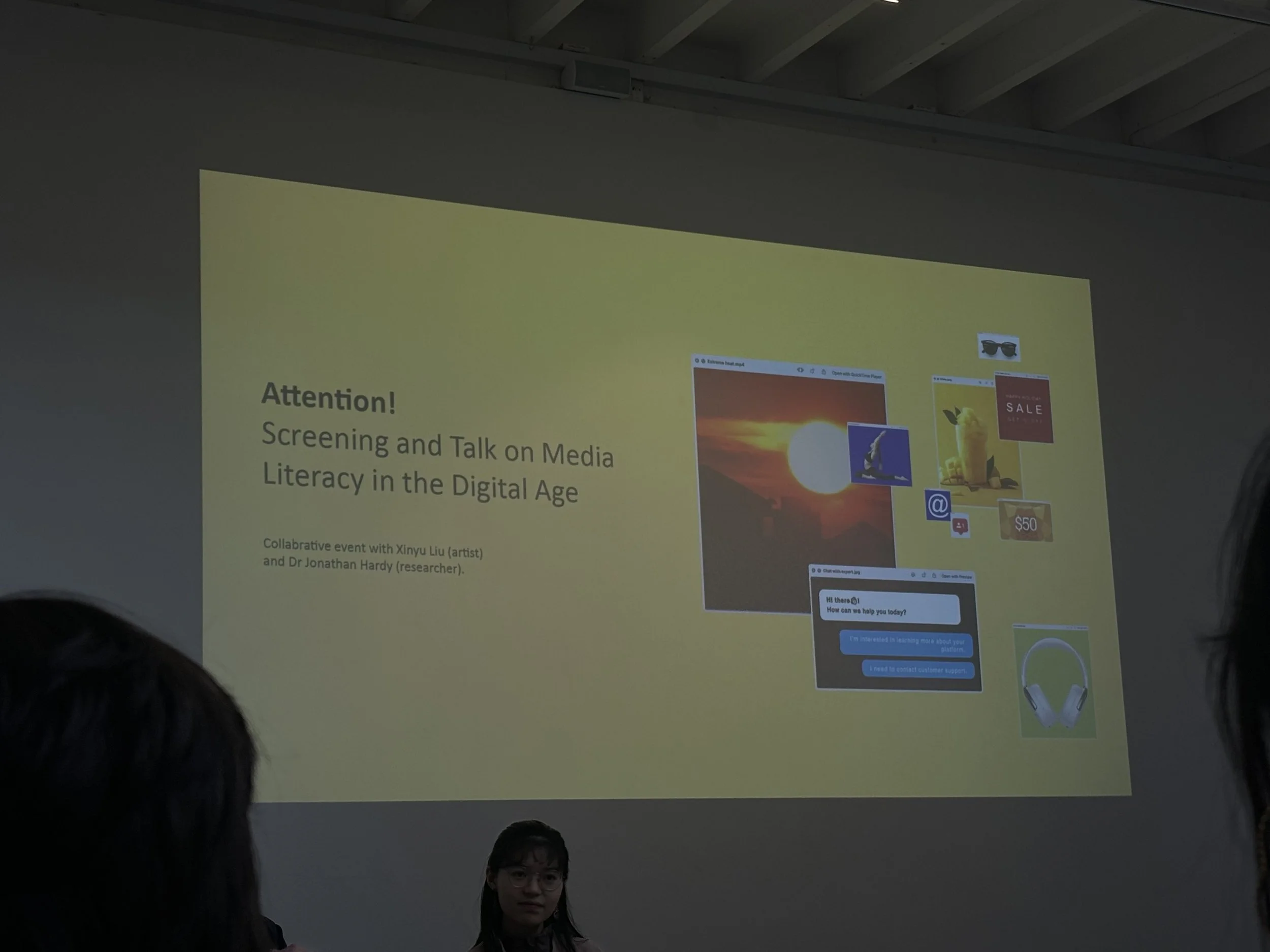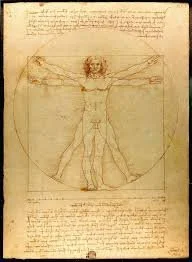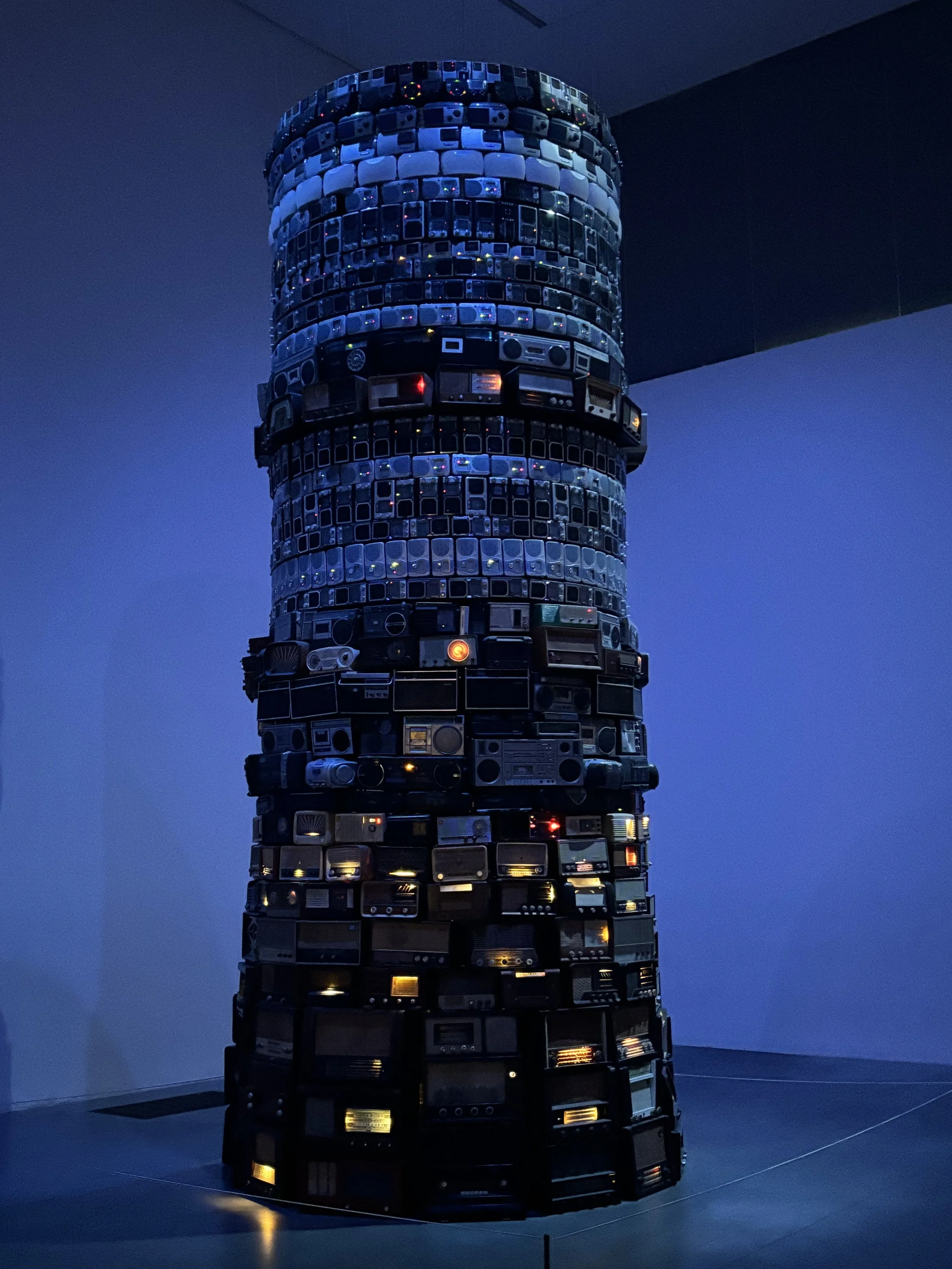research festival with MAFA.
A summary of the student’s work I seen while attending the MAFA research festival at South London Gallery.
Written by Rickyah Blake
Photo taken from presentation by Xinyu Liu
This weekend, I had the pleasure of viewing several presentations at the MA Fine Art Research Festival. First arrived on Friday, I got an opportunity to view the works of a MACA student exploring the intersections of news and advertisements. In this video art, the student acts as a newscaster while reporting on ads, challenging the way modern news is delivered and sponsored by advertisers. Following her presentation there was a Q+A session with a professor at London College of Communication discussing legislation surrounding advertising and data harvesting. This conversation forced me to think more critically on the challenges faced when regulating data collection especially with varying government systems in different parts of the world. A presentation that followed featured a student giving a lecture on the history of Phantasmagoria. Prior to this presentation, I never heard of the word but I marveled at the developments in cinematography. Understanding that film was first modeled after an illusion reminded me of the deeper implications of Hollywood media that I explore in my works. Despite the filmmaking process evolving, there still seems to be a sense of trickery at play between the filmmakers and its viewers.
Photo taken from presentation of Phantasmagoria
Ending off the weekend on Sunday, there were several students who showcased acts of performances. One student recorded their entire process of adding colored cotton balls to a tent that formed a sculpture while this video inter-looped with a performance piece of a student writing quotes on a large sheet of paper. The two pieces worked together to explore the importance of material in art works and the labor that comes from working with that material. Each of these works made me consider the ways I could incorporate performance and technology with everyday materials.
post-humanism with Eleanor Dare.
An introduction to the perspective of post-humanism taught by Eleanor Dare.
Written by Rickyah Blake
On November 19th, 2024, we had lecturer Eleanor Dare visit the MACA cohort. During this time, we discussed the concept of “post-humanism” and how technology can be used as a source of reframing. The term post-humanism refers to a movement that reflects on the relationship between humans and technology. More specifically, Dare views this movement as an opportunity to liberate the body through recognizing it is an extension of oneself. A reference used during the lecture was the work of Leonardo da vinici’s Vitruvian Man. This image is often referred to in the conversations of post-humanism but typically reveals a homogenous viewpoint of technology and its ability to make “a better and stronger man”. The battle to use technology to improve the lives of able-bodied men sets society up to remain under the thumb of patriarchy and racism. Dare challenges this notion by exploring how technology can help society to move past gender and face.
Vitruvian Man by Leonardo da Vinci (1490)
We looked at research projects that exposed the bias in AI systems. Exploring how AI perpetuates prejudicial bias such as not recognizing Black features or categorizing people’s race and gender based on looks. The systemic and algorithmic bias in AI is a dangerous one but reminds us that they are human made mechanisms. Technologies’ functionality is a reflection of the human that made it. When looking at posthumanism, we must abandon the generic definition applied to the movement. In the rise of technological innovation, one must choose a side that will benefit all human beings, by not supporting the systems reinforcing the ills of modern society.
References:
Ethics Centre, 2023. *Ethics Explainer: Post-Humanism*. [online] Available at: <https://ethics.org.au/ethics-explainer-post-humanism/>
visit to Tate Modern.
A roundup of my visit the Tate Modern in London.
Written by Rickyah Blake
Photo of Babel (2001)
In my visit to the Tate Modern, I recognized the importance of accessibility in art spaces. Being able to see contemporary art for free allows for attendees to resonate and explore subject matters outside of their daily lives. During my time at Tate, I spent most of it viewing a floor dedicated to “how artists respond to mass media and the ever-changing technologies that shape our world”. The work that inspired me the most is Cildo Meireles’ Babel (2001) which features an installation of radios turned to different stations stacked on top of each other. This work reflects on technology and its relation to God. The viewpoint of questioning whether God or a higher power is satisfied with human dependence on technology is one I, too, explore in my works. Has modern technology become our Gods? Do we worship our devices?
Selfie in interactive exhibit
While there, I had the pleasure of viewing Electric Dreams, an exhibit exploring art and technology before the internet. The Electric Dreams exhibition at Tate Modern is an opportunity to see the history of computational art practice. The exhibition held various disciplines revealing that computational art goes beyond utilizing technology in art but is more about reflecting on technology in art. One of my favorite parts of the exhibition featured a red and bed hallway with a shelf of mirrors. Each mirror distorted your image to mimic the concept of a different perspective. Interactive installations are a great way for viewers to truly see how computation is in everyday life. Many of the artists made their works interactive where viewers had to participate to fully experience the work. Families crowded around to view projects and touch materials that were a part of the installations.
References:
Tate, 2023. *Electric Dreams: Exhibition Guide*. [online] Available at: <https://www.tate.org.uk/whats-on/tate-modern/electric-dreams/exhibition-guide>








